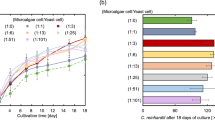Abstract
In this study, after screening of eight fungal strains for their ability to produce calcium malate, it was found that Penicillium viticola 152 isolated from marine algae among them could produce the highest titer of calcium malate. At the same time, it was found that corn steep liquor (CSL) could stimulate calcium malate production and 0.5 % (v/v) CSL was the most suitable for calcium malate production. Under the optimal conditions, a titer of calcium malate in the supernatant was 132 g/l at flask level. During a 10-l fermentation, a titer of 168 g/l, a yield of 1.28 g/g of glucose, and a productivity of 1.75 g/l/h were reached within 96 h of the fermentation, and 93.4 % of the sugar was used for calcium malate production and cell growth, demonstrating that the titer, yield, and productivity of calcium malate by this fungal strain were very high and the fermentation period was very short. After analysis of the partially purified product with high-performance liquid chromatography, it was found that the main product was calcium malate. The results demonstrated that P. viticola 152 obtained in this study was the most suitable for developing a novel one-step fermentation process for calcium malate production from glucose on a large scale.






Similar content being viewed by others
References
Battat E, Peleg Y, Bercovitz A, Rokem JS, Goldberg I (1991) Optimization of l-malic acid production by Aspergillus flavus in a stirred fermentor. Biotechnol Bioeng 37:1108–1116
Cassio F, Leao C (1993) A comparative study on the transport of l(−)-malic acid and other short-chain carboxylic acids in the yeast Candida utilis: evidence for a general organic acid permease. Yeast 9:743–752
Chi ZM, Liu J, Zhang W (2001) Trehalose accumulation from soluble starch by Saccharomycopsis fibuligera sdu. Enz Microb Technol 38:240–246
Gadagi RS, Shin WS, Sa TM (2007) Malic acid mediated aluminum phosphate solubilization by Penicillium oxalicum CBPS-3F-Tsa isolated from Korean paddy rhizosphere soil. In: E. Vela′ zquez and C. Rodrı′guez-Barrueco (eds.), First International Meeting on Microbial Phosphate Solubilization, Springer, pp: 285–290
Goldberg I, Rokem JS, Pines O (2006) Organic acids: old metabolites, new themes. J Chem Technol Biotechnol 81:1601–1611
Kawagoe M, Hyakumura K, Suye SI, Miki K, Naoe K (1997) Application of bubble column fermentors to submerged culture of Schizophyllum commune for production of l-malic acid. J Ferment Bioeng 84:333–336
Kurtzman CP, Fell JW (2000) The yeasts. A taxonomic study, fourth revised and enlarged ed. Elsevier, Amsterdam, Lausanne, New York, Oxford, Shannon, Singapore, Tokyo, pp. 222–360
Liu P, Jarboe LR (2012) Metabolic engineering of biocatalysts for carboxylic acids production. Comput Struct Biotechnol J 3:1–9
Moon SY, Hong SH, Kim TY, Lee SY (2008) Metabolic engineering of Escherichia coli for the production of malic acid. Biochem Eng J 40:312–320
Mu L, Wen J (2013) Engineered Bacillus subtilis 168 produces l-malate by heterologous biosynthesis pathway construction and lactate dehydrogenase deletion. World J Microbiol Biotechnol 29:33–41
Nonaka K, Masuma R, Iwatsuki M, Shiomi K, Otoguro K, Omura S (2011) Penicillium viticola, a new species isolated from a grape in Japan. Mycosci 52:338–343
Pedersen LH, Skouboe P, Boysen M, Souleb J, Rossen L (1997) Detection of Penicillium species in complex food samples using the polymerase chain reaction. Intern J Food Microbiol 35:169–177
Peleg Y, Rahamin E, Kessel M, Goldberg I (1988) Malic acid accumulation by Aspergillus flavus. II, Crystals and hair-like processes formed by A. flavus in a l-malic acid production medium. Appl Microbiol Biotechnol 28:26–29
Presecki AV, Vasic-Racki D (2005) Production of l-malate by permeabilized cells of commercial Saccharomyces sp. strains. Biotechnol Lett 27:1835–1839
Sharma N, Prasad GS, Choudhury AR (2013) Utilization of corn steep liquor for biosynthesis of pullulan, an important exopolysaccharide. Carboh Polym 93:95–101
Spiro RG (1966) Analysis of sugars found in glycoproteins. Meth Enzymol 8:3–26
Stojkovic G, Znidarsic-Plazl P (2012) Continuous synthesis of l-malic acid using whole-cell microreactor. Proc Biochem 47:1102–1107
Taing O, Taing K (2007) Production of malic and succinic acids by sugar-tolerant yeast Zygosaccharomyces rouxii. Eur Food Res Technol 224:343–347
Tamura K, Dudley J, Nei M, Kumar S (2007) MEGA4: molecular evolutionary genetics analysis (MEGA) software version 4.0. Mol Biol Evol 24:1596–1599
Wang ZP, Wang GY, Khan I, Chi ZM (2013) High-level production of calcium malate from glucose by Penicillium sclerotiorum K302. Biores Technol 143:674–677
West TP (2011) Malic acid production from thin stillage by Aspergillus species. Biotechnol Lett 33:2463–2467
Zelle RM, de Hulster E, van Winden WA, de Waard P, Dijkema C, Winkler AA, Geertman JMA, van Dijken JP, Pronk JT, van Maris AJA (2008) Malic acid production by Saccharomyces cerevisiae: engineering of pyruvate carboxylation, oxaloacetate reduction, and malate export. Appl Environ Microbiol 74:2766–2777
Zhang H, Cai J, Dong J, Zhang D, Huang L, Xu Z, Cen P (2011) High level production of poly (β-l-malic acid) with a new isolated Aureobasidium pullulans strain. Appl Microbiol Biotechnol 92:295–303
Zou X, Zhou Y, Yang ST (2013) Production of polymalic acid and malic acid by Aureobasidium pullulans fermentation and acid hydrolysis. Biotechnol Bioeng 11:2105–2113
Acknowledgments
This research was supported by Hi-Tech Research and Development Program of China (Grant No. 2013BAB01B05).
Author information
Authors and Affiliations
Corresponding author
Rights and permissions
About this article
Cite this article
Khan, I., Nazir, K., Wang, ZP. et al. Calcium malate overproduction by Penicillium viticola 152 using the medium containing corn steep liquor. Appl Microbiol Biotechnol 98, 1539–1546 (2014). https://doi.org/10.1007/s00253-013-5326-7
Received:
Revised:
Accepted:
Published:
Issue Date:
DOI: https://doi.org/10.1007/s00253-013-5326-7




